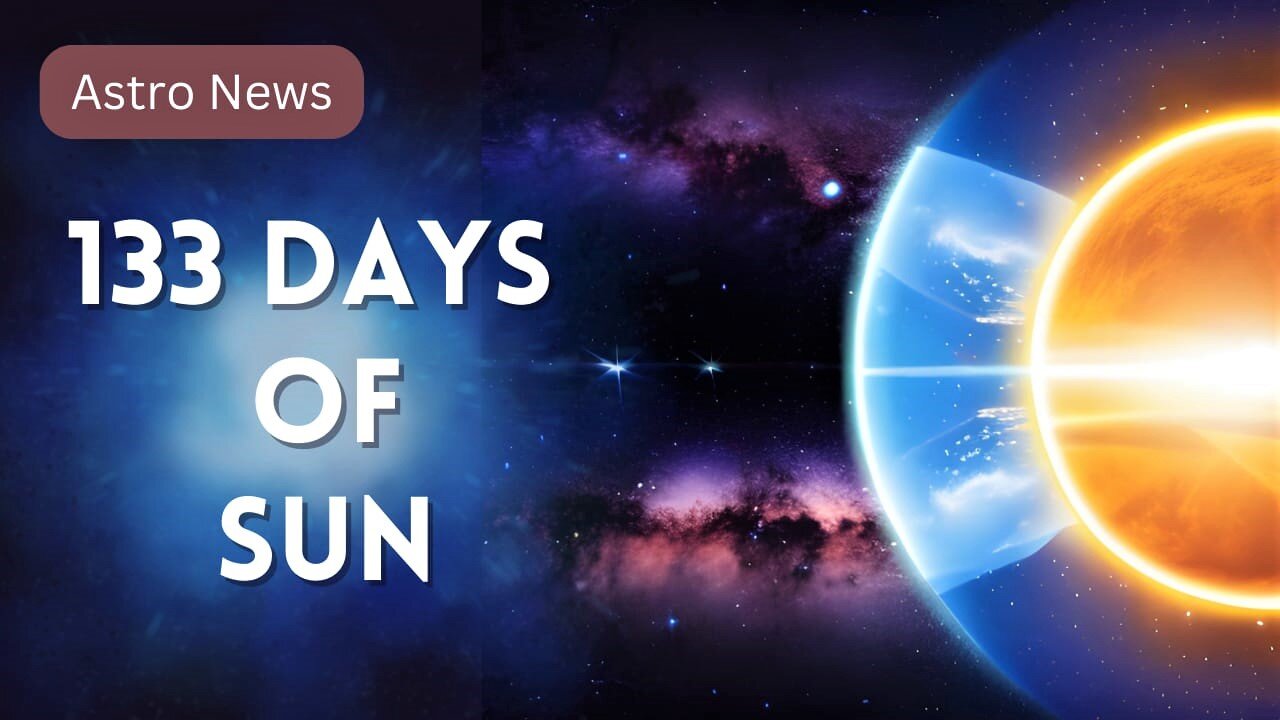Premium Only Content

133 Days of Sun From Space
The Sun appears quite different when viewed from space compared to how it appears from Earth's surface. Here are some key characteristics of how the Sun looks when observed from space:
A Constantly Shining Star: The Sun is a giant ball of hot, glowing gas, primarily hydrogen and helium. From space, it appears as a brilliant, radiant sphere of intense light. It emits a constant stream of energy through nuclear fusion reactions in its core, which is why it shines so brightly.
No Atmosphere: Unlike Earth, the Sun has no atmosphere. When viewed from space, there is no distortion or scattering of its light by Earth's atmosphere, which can create the familiar blue sky and sunset colors we see from the surface. Instead, it appears as a pure, white or yellow-white sphere.
Solar Corona: During a total solar eclipse, the Sun's outer atmosphere, called the corona, becomes visible. This can also be observed from space when the Moon passes in front of the Sun. The corona is a faint, wispy halo of plasma extending far from the Sun's surface, composed of ionized gas. It is visible as a delicate, glowing halo with streamers and loops extending outward.
Solar Flares and Prominences: From space-based observatories like the Solar and Heliospheric Observatory (SOHO) or the Solar Dynamics Observatory (SDO), scientists can capture detailed images of the Sun's surface. These images reveal features such as solar flares (brief eruptions of intense radiation and particles) and solar prominences (huge, looping arcs of plasma extending from the Sun's surface).
Constantly Changing Surface: The Sun's surface, known as the photosphere, is not static. It is marked by dark spots called sunspots, bright regions called faculae, and granules caused by the churning motion of hot gas. These features can be observed and tracked from space, providing valuable information about the Sun's activity.
Different Views at Different Wavelengths: Space-based observatories allow scientists to observe the Sun in various wavelengths of light, including ultraviolet and X-rays. These observations reveal different layers and aspects of the Sun's behavior, such as its magnetic field and the temperature variations in its atmosphere.
In summary, when viewed from space, the Sun appears as a brilliant, constant source of light without the influence of Earth's atmosphere. It showcases a dynamic and ever-changing surface, and specialized instruments can reveal intricate details about its structure and activity
-
 14:53
14:53
Forrest Galante
12 hours agoAustralia's Top 5 Deadliest Animals
80.2K21 -
 LIVE
LIVE
Perhenmo
15 hours ago【Mega Man】What Could Go Wrong?
31 watching -
 LIVE
LIVE
Joe Donuts Live
6 hours ago🟢 Warzone Live : I'm BACK!! | Can We Dominate Verdansk?
142 watching -
 3:18:47
3:18:47
DLDAfterDark
12 hours ago $9.30 earnedDLD Live! What's The "best" PDW?? Considerations For Trunk/Truck Gun & Gats in Bags & Backpacks
46.9K10 -
 7:09:13
7:09:13
saiyagamertv
8 hours agoIm ready to RUMBLE lets WIN!!
2.47K -
 15:25
15:25
Exploring With Nug
23 hours ago $26.29 earnedBag of Phones Found While Searching For Missing Man In River!
112K31 -
 3:58:27
3:58:27
fuzzypickles168
12 hours agoLate Nite Jam Session - Rock Band 4 | Was: EA Sports WRC | 1 John 2:1-17
46.4K -
![Nintendo Switch It UP Saturdays with The Fellas: LIVE - Episode #13 [Mario Kart 8 Deluxe]](https://1a-1791.com/video/fww1/97/s8/1/1/g/A/z/1gAzy.0kob-small-Nintendo-Switch-It-UP-Satur.jpg) 3:33:38
3:33:38
MoFio23!
22 hours agoNintendo Switch It UP Saturdays with The Fellas: LIVE - Episode #13 [Mario Kart 8 Deluxe]
83.1K1 -
 23:24
23:24
MYLUNCHBREAK CHANNEL PAGE
22 hours agoDams Destroyed Turkey
125K102 -
 7:24:43
7:24:43
SpartanTheDogg
15 hours agoPro Halo Player
85.9K2